本篇内容介绍了“Java的流程控制语句有哪些”的有关知识,在实际案例的操作过程中,不少人都会遇到这样的困境,接下来就让小编带领大家学习一下如何处理这些情况吧!希望大家仔细阅读,能够学有所成!
01、if-else 相关
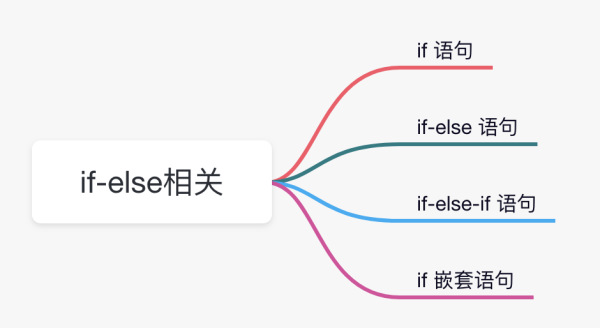
1)if 语句
if 语句的格式如下:
if(布尔表达式){ // 如果条件为 true,则执行这块代码 }画个流程图表示一下:
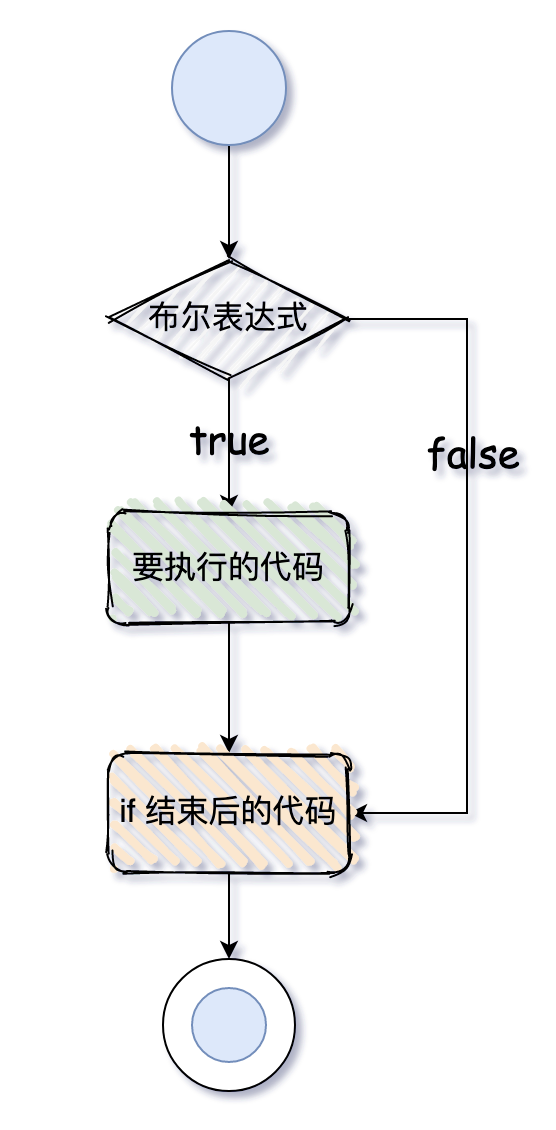
来写个示例:
public class IfExample { public static void main(String[] args) { int age = 20; if (age < 30) { System.out.println("青春年华"); } } }输出:
青春年华
2)if-else 语句
if-else 语句的格式如下:
if(布尔表达式){ // 条件为 true 时执行的代码块 }else{ // 条件为 false 时执行的代码块 }画个流程图表示一下:
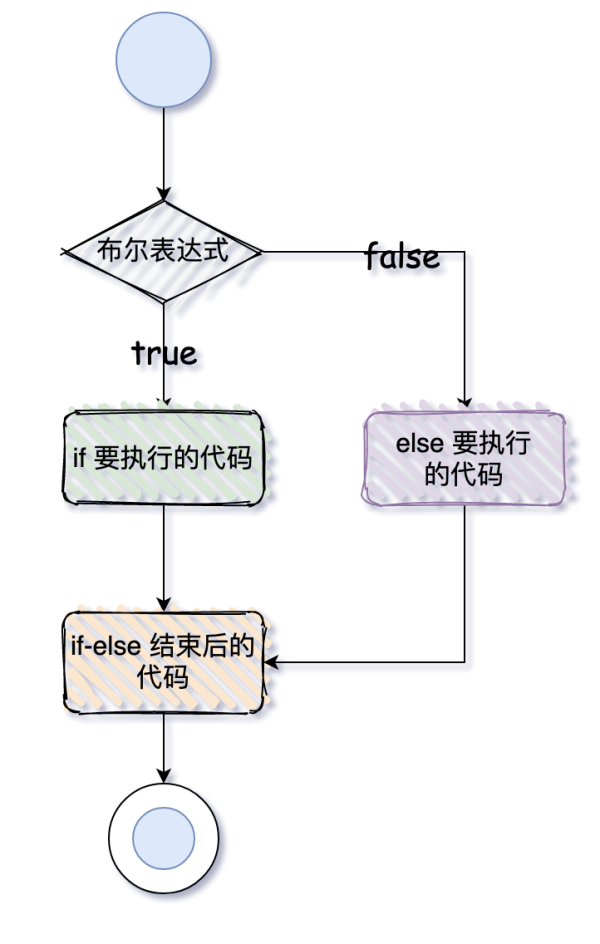
来写个示例:
public class IfElseExample { public static void main(String[] args) { int age = 31; if (age < 30) { System.out.println("青春年华"); } else { System.out.println("而立之年"); } } }输出:
而立之年
除了这个例子之外,还有一个判断闰年(被 4 整除但不能被 100 整除或者被 400 整除)的例子:
public class LeapYear { public static void main(String[] args) { int year = 2020; if (((year % 4 == 0) && (year % 100 != 0)) || (year % 400 == 0)) { System.out.println("闰年"); } else { System.out.println("普通年份"); } } }输出:
闰年
如果执行语句比较简单的话,可以使用三元运算符来代替 if-else 语句,如果条件为 true,返回 ? 后面 : 前面的值;如果条件为 false,返回 : 后面的值。
public class IfElseTernaryExample { public static void main(String[] args) { int num = 13; String result = (num % 2 == 0) ? "偶数" : "奇数"; System.out.println(result); } }输出:
奇数
3)if-else-if 语句
if-else-if 语句的格式如下:
if(条件1){ // 条件1 为 true 时执行的代码 }else if(条件2){ // 条件2 为 true 时执行的代码 } else if(条件3){ // 条件3 为 true 时执行的代码 } ... else{ // 以上条件均为 false 时执行的代码 }画个流程图表示一下:

来写个示例:
public class IfElseIfExample { public static void main(String[] args) { int age = 31; if (age < 30) { System.out.println("青春年华"); } else if (age >= 30 && age < 40 ) { System.out.println("而立之年"); } else if (age >= 40 && age < 50 ) { System.out.println("不惑之年"); } else { System.out.println("知天命"); } } }输出:
而立之年
4)if 嵌套语句
if 嵌套语句的格式如下:
if(外侧条件){ // 外侧条件为 true 时执行的代码 if(内侧条件){ // 内侧条件为 true 时执行的代码 } }画个流程图表示一下:

来写个示例:
public class NestedIfExample { public static void main(String[] args) { int age = 20; boolean isGirl = true; if (age >= 20) { if (isGirl) { System.out.println("女生法定结婚年龄"); } } } }输出:
女生法定结婚年龄
02、switch 语句
switch 语句用来判断变量与多个值之间的相等性。变量的类型可以是 byte、short、int、long,或者对应的包装器类型 Byte、Short、Integer、Long,以及字符串和枚举。
来看一下 switch 语句的格式:
switch(变量) { case 可选值1: // 可选值1匹配后执行的代码; break; // 该关键字是可选项 case 可选值2: // 可选值2匹配后执行的代码; break; // 该关键字是可选项 ...... default: // 该关键字是可选项 // 所有可选值都不匹配后执行的代码 }变量可以有 1 个或者 N 个值。
值类型必须和变量类型是一致的,并且值是确定的。
值必须是唯一的,不能重复,否则编译会出错。
break 关键字是可选的,如果没有,则执行下一个 case,如果有,则跳出 switch 语句。
default 关键字也是可选的。
画个流程图:
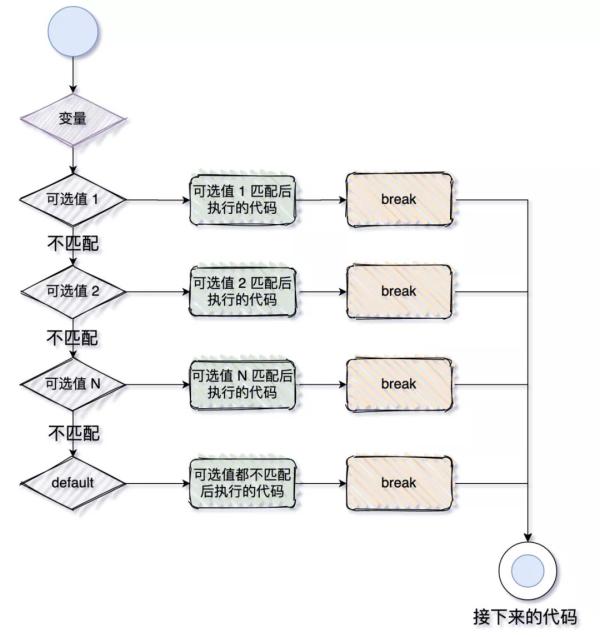
来个示例:
public class Switch2 { public static void main(String[] args) { int age = 20; switch (age) { case 20 : System.out.println("上学"); break; case 24 : System.out.println("苏州工作"); break; case 30 : System.out.println("洛阳工作"); break; default: System.out.println("未知"); break; // 可省略 } } }输出:
上学
当两个值要执行的代码相同时,可以把要执行的代码写在下一个 case 语句中,而上一个 case 语句中什么也没有,来看一下示例:
public class Switch3 { public static void main(String[] args) { String name = "沉默王二"; switch (name) { case "詹姆斯": System.out.println("篮球运动员"); break; case "穆里尼奥": System.out.println("足球教练"); break; case "沉默王二": case "沉默王三": System.out.println("乒乓球爱好者"); break; default: throw new IllegalArgumentException( "名字没有匹配项"); } } }输出:
乒乓球爱好者
枚举作为 switch 语句的变量也很常见,来看例子:
public class SwitchEnumDemo { public enum PlayerTypes { TENNIS, FOOTBALL, BASKETBALL, UNKNOWN } public static void main(String[] args) { System.out.println(createPlayer(PlayerTypes.BASKETBALL)); } private static String createPlayer(PlayerTypes playerType) { switch (playerType) { case TENNIS: return "网球运动员费德勒"; case FOOTBALL: return "足球运动员C罗"; case BASKETBALL: return "篮球运动员詹姆斯"; case UNKNOWN: throw new IllegalArgumentException("未知"); default: throw new IllegalArgumentException( "运动员类型: " + playerType); } } }输出:
篮球运动员詹姆斯
03、for 循环

1)普通 for 循环
普通的 for 循环可以分为 4 个部分:
1)初始变量:循环开始执行时的初始条件。
2)条件:循环每次执行时要判断的条件,如果为 true,就执行循环体;如果为 false,就跳出循环。当然了,条件是可选的,如果没有条件,则会一直循环。
3)循环体:循环每次要执行的代码块,直到条件变为 false。
4)自增/自减:初识变量变化的方式。
来看一下普通 for 循环的格式:
for(初识变量;条件;自增/自减){ // 循环体 }画个流程图:

来个示例:
public class ForExample { public static void main(String[] args) { for (int i = 0; i < 5; i++) { System.out.println("沉默王三好美啊"); } } }输出:
沉默王三好美啊 沉默王三好美啊 沉默王三好美啊 沉默王三好美啊 沉默王三好美啊
“哎呀,二哥,你真的是变着法夸我啊。”
“非也非也,三妹,你看不出我其实在夸我自己吗?循环语句还可以嵌套呢,这样就可以打印出更好玩的呢,你要不要看看?”
“好呀好呀!”
“看好了啊。”
public class PyramidForExample { public static void main(String[] args) { for (int i = 0; i < 5; i++) { for (int j = 0;j<= i;j++) { System.out.print("❤"); } System.out.println(); } } }打印出什么玩意呢?
❤ ❤❤ ❤❤❤ ❤❤❤❤ ❤❤❤❤❤
“哇,太不可思议了,二哥。”
“嘿嘿。”
2)for-each
for-each 循环通常用于遍历数组和集合,它的使用规则比普通的 for 循环还要简单,不需要初始变量,不需要条件,不需要下标来自增或者自减。来看一下语法:
for(元素类型 元素 : 数组或集合){ // 要执行的代码 }来看一下示例:
public class ForEachExample { public static void main(String[] args) { String[] strs = {"沉默王二", "一枚有趣的程序员"}; for (String str : strs) { System.out.println(str); } } }输出:
沉默王二 一枚有趣的程序员
“呀,二哥,你开始王哥卖瓜了啊。”
“嘿嘿,三妹,你这样说哥会脸红的。”
3)无限 for 循环
“三妹,你想不想体验一下无限 for 循环的威力,也就是死循环。”
“二哥,那会有什么样的后果啊?”
“来,看看就知道了。”
public class InfinitiveForExample { public static void main(String[] args) { for(;;){ System.out.println("停不下来。。。。"); } } }输出:
停不下来。。。。 停不下来。。。。 停不下来。。。。 停不下来。。。。
一旦运行起来,就停不下来了,除非强制停止。
04、while 循环
来看一下 while 循环的格式:
while(条件){ //循环体 }画个流程图:

来个示例:
public class WhileExample { public static void main(String[] args) { int i = 0; while (true) { System.out.println("沉默王三"); i++; if (i == 5) { break; } } } }“三妹,你猜猜会输出几次?”
“五次吗?”
“对了,你可真聪明。”
沉默王三 沉默王三 沉默王三 沉默王三 沉默王三
“三妹,你想不想体验一下无限 while 循环的威力,也就是死循环。”
“二哥,那会有什么样的后果啊?”
“来,看看就知道了。”
public class InfinitiveWhileExample { public static void main(String[] args) { while (true) { System.out.println("停不下来。。。。"); } } }输出:
停不下来。。。。 停不下来。。。。 停不下来。。。。 停不下来。。。。
把 while 的条件设置为 true,并且循环体中没有 break 关键字的话,程序一旦运行起来,就根本停不下来了,除非强制停止。
05、do-while 循环
来看一下 do-while 循环的格式:
do{ // 循环体 }while(提交);画个流程图:
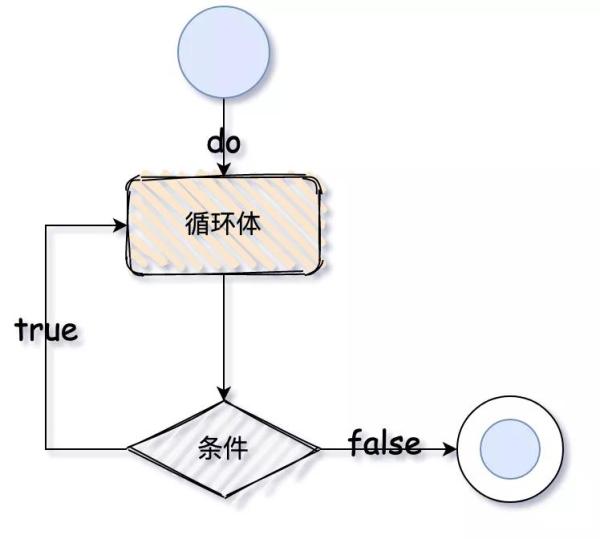
来个示例:
public class DoWhileExample { public static void main(String[] args) { int i = 0; do { System.out.println("沉默王三"); i++; if (i == 5) { break; } } while (true); } }“三妹,你猜猜会输出几次?”
“五次吗?”
“对了,你可真聪明。”
沉默王三 沉默王三 沉默王三 沉默王三 沉默王三
“三妹,你想不想体验一下无限 do-while 循环的威力......”
“二哥,又来啊,我都腻了。”
“来吧,例行公事,就假装看看嘛。”
public class InfinitiveDoWhileExample { public static void main(String[] args) { do { System.out.println("停不下来。。。。"); } while (true); } }输出:
停不下来。。。。 停不下来。。。。 停不下来。。。。 停不下来。。。。
把 do-while 的条件设置为 true,并且循环体中没有 break 关键字的话,程序一旦运行起来,就根本停不下来了,除非强制停止。

06、break
break 关键字通常用于中断循环或 switch 语句,它在指定条件下中断程序的当前流程。如果是内部循环,则仅中断内部循环。
可以将 break 关键字用于所有类型循环语句中,比如说 for 循环、while 循环,以及 do-while 循环。
来画个流程图感受一下:

用在 for 循环中的示例:
for (int i = 1; i <= 10; i++) { if (i == 5) { break; } System.out.println(i); }用在嵌套 for 循环中的示例:
for (int i = 1; i <= 3; i++) { for (int j = 1; j <= 3; j++) { if (i == 2 && j == 2) { break; } System.out.println(i + " " + j); } }用在 while 循环中的示例:
int i = 1; while (i <= 10) { if (i == 5) { i++; break; } System.out.println(i); i++; }用在 do-while 循环中的示例:
int j = 1; do { if (j == 5) { j++; break; } System.out.println(j); j++; } while (j <= 10);用在 switch 语句中的示例:
switch (age) { case 20 : System.out.println("上学"); break; case 24 : System.out.println("苏州工作"); break; case 30 : System.out.println("洛阳工作"); break; default: System.out.println("未知"); break; // 可省略 }07、continue
当我们需要在 for 循环或者 (do)while 循环中立即跳转到下一个循环时,就可以使用 continue 关键字,通常用于跳过指定条件下的循环体,如果循环是嵌套的,仅跳过当前循环。
来个示例:
public class ContinueDemo { public static void main(String[] args) { for (int i = 1; i <= 10; i++) { if (i == 5) { // 使用 continue 关键字 continue;// 5 将会被跳过 } System.out.println(i); } } }输出:
1 2 3 4 6 7 8 9 10
“二哥,5 真的被跳过了呀。”
“那必须滴。不然就是 bug。”
再来个循环嵌套的例子。
public class ContinueInnerDemo { public static void main(String[] args) { for (int i = 1; i <= 3; i++) { for (int j = 1; j <= 3; j++) { if (i == 2 && j == 2) { // 当i=2,j=2时跳过 continue; } System.out.println(i + " " + j); } } } }打印出什么玩意呢?
1 1 1 2 1 3 2 1 2 3 3 1 3 2 3 3
“2 2” 没有输出,被跳过了。
再来看一下 while 循环时 continue 的使用示例:
public class ContinueWhileDemo { public static void main(String[] args) { int i = 1; while (i <= 10) { if (i == 5) { i++; continue; } System.out.println(i); i++; } } }输出:
1 2 3 4 6 7 8 9 10
注意:如果把 if 条件中的“i++”省略掉的话,程序就会进入死循环,一直在 continue。
最后,再来看一下 do-while 循环时 continue 的使用示例:
public class ContinueDoWhileDemo { public static void main(String[] args) { int i=1; do{ if(i==5){ i++; continue; } System.out.println(i); i++; }while(i<=10); } }输出:
1 2 3 4 6 7 8 9 10
注意:同样的,如果把 if 条件中的“i++”省略掉的话,程序就会进入死循环,一直在 continue。
“Java的流程控制语句有哪些”的内容就介绍到这里了,感谢大家的阅读。如果想了解更多行业相关的知识可以关注亿速云网站,小编将为大家输出更多高质量的实用文章!
免责声明:本站发布的内容(图片、视频和文字)以原创、转载和分享为主,文章观点不代表本网站立场,如果涉及侵权请联系站长邮箱:is@yisu.com进行举报,并提供相关证据,一经查实,将立刻删除涉嫌侵权内容。